
Nantucket is an island about 30 miles (50 km) south from Cape Cod. Together with the small islands of Tuckernuck and Muskeget, it constitutes the Town and County of Nantucket, a combined county/town government that is part of the U.S. state of Massachusetts. It is the only such consolidated town-county in Massachusetts. As of the 2020 census, the population was 14,255, making it the least populated county in Massachusetts. Part of the town is designated the Nantucket CDP, or census-designated place. The region of Surfside on Nantucket is the southernmost settlement in Massachusetts.
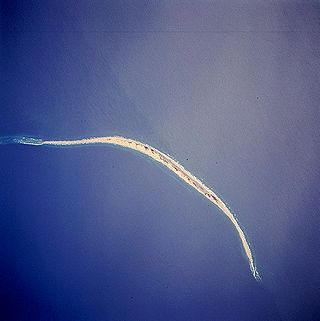
Sable Island is a small Canadian island situated 300 km (190 mi) southeast of Halifax, Nova Scotia, and about 175 km (109 mi) southeast of the closest point of mainland Nova Scotia in the North Atlantic Ocean. The island is staffed year round by three federal government staff, rising during summer months when research projects and tourism increase. Notable for its role in early Canadian history and the Sable Island horse, the island is protected and managed by Parks Canada, which must grant permission prior to any visit. Sable Island is part of District 7 of the Halifax Regional Municipality in Nova Scotia. The island is also a protected National Park Reserve and an Important Bird Area.

Hull is a town in Plymouth County, Massachusetts, United States, located on a peninsula at the southern edge of Boston Harbor. Its population was 10,072 at the 2020 census. Hull is the smallest town by land area in Plymouth County and the fourth smallest in the state. However, its population density is nearly four times that of Massachusetts as a whole.
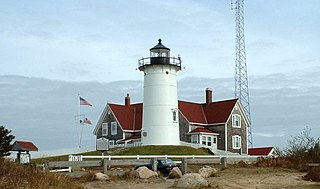
Falmouth is a town in Barnstable County, Massachusetts, United States. The population was 32,517 at the 2020 census, making Falmouth the second-largest municipality on Cape Cod after Barnstable. The terminal for the Steamship Authority ferries to Martha's Vineyard is located in the village of Woods Hole in Falmouth. Woods Hole also contains several scientific organizations such as the Woods Hole Oceanographic Institution (WHOI), the Marine Biological Laboratory (MBL), the Woodwell Climate Research Center, NOAA's Woods Hole Science Aquarium, and the scientific institutions' various museums.

The Gold Lifesaving Medal and Silver Lifesaving Medal are U.S. decorations issued by the United States Coast Guard. The awards were established by Act of Congress, 20 June 1874; later authorized by 14 U.S.C. § 500. These decorations are two of the oldest medals in the United States and were originally established at the Department of Treasury as Lifesaving Medals First and Second Class. The Department of the Treasury initially gave the award, but today the United States Coast Guard awards it through the Department of Homeland Security. They are not classified as military decorations, and may be awarded to any person.

The United States Life-Saving Service was a United States government agency that grew out of private and local humanitarian efforts to save the lives of shipwrecked mariners and passengers. It began in 1848 and ultimately merged with the Revenue Cutter Service to form the United States Coast Guard in 1915.
Graveyard of the Atlantic is a nickname for the treacherous waters and area of numerous shipwrecks off the Outer Banks of North Carolina, United States, which are due to the coast's shifting sands and inlets. To a lesser degree, this nickname has also been applied to Sable Island off of Nova Scotia, Canada, as well as the waters off Cape Cod, Massachusetts, United States.
Seatack, Virginia is a historic neighborhood and community borough of Virginia Beach, Virginia that was located in what used to be Princess Anne County, and is now part of the Oceanfront resort strip and adjacent area of the independent city of Virginia Beach. The Seatack community of Virginia Beach includes an area inland from the resort strip along present-day Virginia Beach Boulevard. Seatack Elementary School is located nearby on Birdneck Road. The 1903 Seatack Station of the United States Lifesaving Service is now the Virginia Beach Surf & Rescue Museum located at 24th street adjacent to the oceanfront boardwalk.

The Virginia Beach Surf & Rescue Museum honors and preserves the history of Virginia's maritime heritage, coastal communities, the United States Lifesaving Service, and the United States Coast Guard along the Atlantic coast.
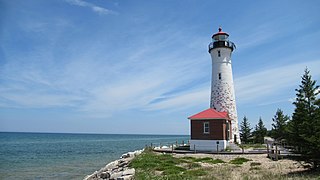
Crisp Point was one of five U.S. Life-Saving Service Stations along the coast of Lake Superior between Munising and Whitefish Point in the Upper Peninsula of Michigan. The lighthouse is within McMillan Township in Luce County.
Rasmus S. Midgett (1851–1926) was a United States Life-Saving Service surfman in North Carolina who single-handedly rescued ten men from the sinking barkentine Priscilla and was thereafter awarded the Gold Lifesaving Medal from the Secretary of the Treasury on October 18, 1899.

Lifesaving is the act involving rescue, resuscitation and first aid. It often refers to water safety and aquatic rescue; however, it could include ice rescue, flood and river rescue, swimming pool rescue and other emergency medical services. Lifesaving also refers to sport where lifesavers compete based on skills, speed and teamwork. Lifesaving activities specialized in oceanic environment is called surf lifesaving or coastal lifesaving.
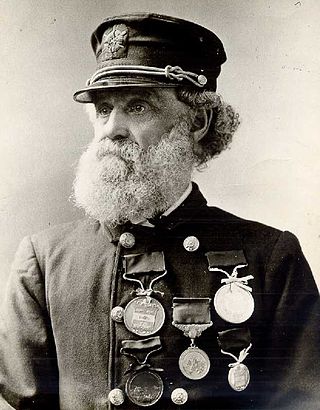
Joshua James was an American sea captain and a U.S. Life–Saving Station keeper. He was a famous and celebrated commander of civilian life-saving crews in the 19th century, credited with saving over 500 lives from the age of about 15 when he first associated himself with the Massachusetts Humane Society until his death at the age of 75 while on duty with the United States Life–Saving Service. During his lifetime he was honored with the highest medals of the Humane Society and the United States. His father, mother, brothers, wife, and son were also lifesavers in their own right.
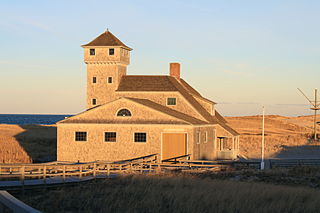
The Old Harbor U.S. Life Saving Station is a historic maritime rescue station and museum, located at Race Point Beach in Provincetown, Massachusetts. Built in 1897, it was originally located at Nauset Beach near the entrance to Chatham Harbor in Chatham, Massachusetts. It was used by the United States Life-Saving Service (USLSS), and then by its successor, the United States Coast Guard (USCG), as the Old Harbor Coast Guard Station. The station was decommissioned in 1944, abandoned and sold as surplus in 1947, and was used as a private residence for the next twenty-six years.
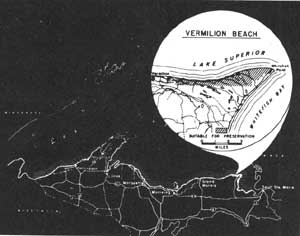
Vermilion Point is a remote, undeveloped shore in Chippewa County, Michigan, United States. Located 9.75 miles (15.69 km) west of Whitefish Point, Michigan, this historic spot lies on a stretch of Lake Superior’s southeast coast known as the "Graveyard of the Great Lakes" or the "Shipwreck Coast". The servicemen of Vermilion Lifesaving Station performed daring rescues of shipwrecks from 1877 until 1944 when it was closed after modern navigational technology made this service obsolete.
The ILS World Life Saving Championships are the world championships for lifesaving sport events. They are sanctioned by the International Life Saving Federation (ILS), conducted every 2 years, and commonly marketed and known as the ‘Rescue’ series, for example – Rescue 2008.
The Powhattan or Powhatan was a United States ship that is best remembered as one of the New Jersey shipwrecks with the greatest loss of life. The number of victims varies, according to sources, between 200 and 365.
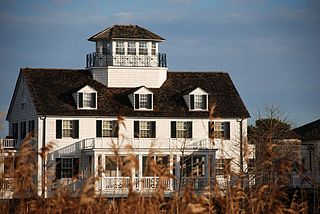
Coast Guard Station Cobb Island is a former United States Coast Guard Station that was built on the southern end of Cobb Island, Virginia, one of Virginia's Barrier Islands, on Virginia's Eastern Shore, in 1936, to replace an earlier c. 1877 Coast Guard Station that had been damaged by a hurricane. The Coast Guard decommissioned Station Cobb Island in 1964. The Nature Conservancy (TNC) acquired the abandoned former Station Cobb Island in 1973. TNC moved the buildings comprising the former Station Cobb Island, by barge, eight miles across Cobb Island Bay, to a newly prepared site in Oyster, Northampton County, Virginia, on Virginia's Eastern Shore, in May 1998. TNC subsequently restored the former Station Cobb Island as a nature education center/lodge/conference center through adaptive reuse. The property is currently listed for sale.

The Humane Society of the Commonwealth of Massachusetts, better known as the Massachusetts Humane Society was founded in 1786 by a group of Boston citizens who were concerned about the needless deaths resulting from shipwrecks and drownings and wanted to find ways to save lives. It was based on the Royal Humane Society, a similar organization established in Great Britain in 1774. The Massachusetts Humane Society became the model for the United States Life-Saving Service funded by Congress in 1848 and operated by the United States Coast Guard since 1915.

The Ocean City Life-Saving Station is the only life-saving station of its design in New Jersey still in existence. Designed by architect James Lake Parkinson in a Carpenter Gothic style, the building is one of 25 stations built of the 1882 life-saving type. It is also one of six still in existence in the country. Construction on the facility began in September 1885 and was completed in the following year. There were two earlier stations in the northern end of Ocean City before this facility was constructed, and there were two stations farther south on the island.














